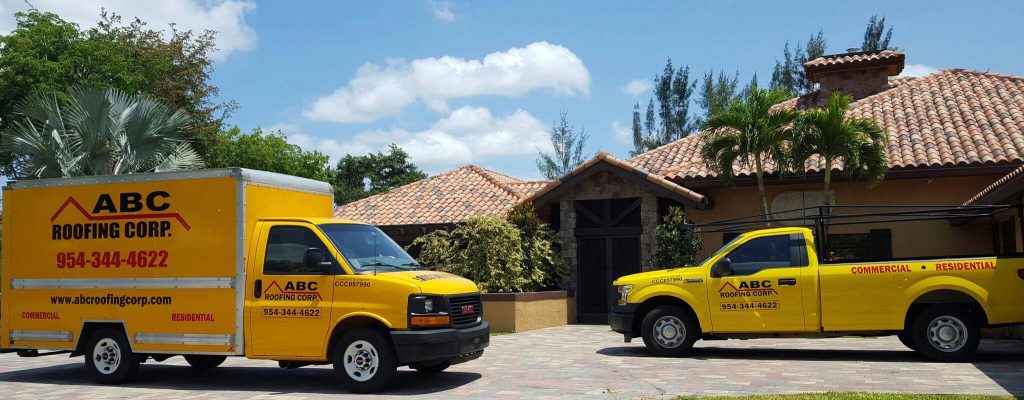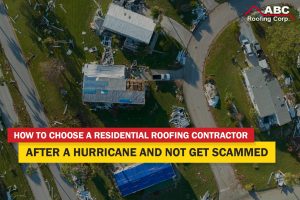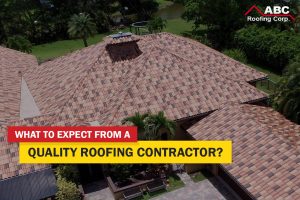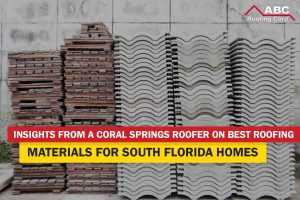
- 1. Obvious Signs of Leaks Inside Your Home
- 2. Missing, Cracked, or Damaged Roof Tiles or Shingles
- 3. Excessive Granule Loss from Shingles
- 4. Sagging Roof Deck or Ceiling
- 5. Algae Growth
- 6. Damaged or Clogged Gutters and Downspouts
- 7. Visible Damage Around Roof Penetrations And Valleys
- 8. An Aging Roof
- Residential Roofing Contractors in Coral Springs & Jupiter
While some homeowners might be tempted to tackle minor roof repairs themselves, roofing work is dangerous and often requires specialized knowledge, tools, and materials. In South Florida, the numerous types of roofs make it even more hazardous, since, depending on the type of roofing material, different safety and regulatory standards need to be applied. A professional residential roofing contractor has the expertise to accurately diagnose the problem and recommend the most effective solutions. They will tailor these to your specific local climate, and perform repairs safely and efficiently while ensuring the job is done right the first time.

In this article, we’ll explain the key signs that indicate your roof needs professional attention from residential roofing contractors. By acting on these indicators early, you can save significant time, money, and stress in the long run, especially during hurricane season.
1. Obvious Signs of Leaks Inside Your Home
This might seem like the most glaringly obvious sign, but it’s crucial to address it immediately. In South Florida, the humid environment is a haven for mold, a troublesome fungus that can proliferate rapidly. Water stains on your ceilings or walls, damp spots, or even the sound of dripping water are clear indicators that your roof has been compromised.
Don’t ignore these signs, as leaks will not go away on their own and will require intervention.
Water intrusion to your roof can lead to a host of serious problems, including:
Rapid Mold and Mildew Growth
The high humidity in South Florida creates an ideal environment for mold and mildew to flourish. The spores released by these fungi can trigger severe allergies and respiratory issues, while their mycelia can cause costly structural damage.
Damaged Insulation
Wet insulation severely impedes its effectiveness (R-value), making your home less energy-efficient. This could potentially lead to higher air conditioning bills.
Rotting Wood
Persistent leaks can saturate the wooden structural components of your roof, leading to rot and weakening its integrity. Wood-framed homes are one of the most common types of homes in South Florida. There’s a good chance that this could cost you a pretty penny if the leaks are left unaddressed.
2. Missing, Cracked, or Damaged Roof Tiles or Shingles
Many South Florida roofs often feature clay tiles, cement tiles, asphalt shingles, and even wooden shakes.. All of these roof coverings are susceptible to damage from the harsh sun and damaging winds. A good bit of advice is to regularly inspect your roof (from the ground, for safety reasons) for any signs of missing, cracked, chipped, or displaced tiles or shingles.
Essentially, if your roof covering is looking in any way worse for wear then your roof is exposed to the elements and will need to be repaired by a professional residential roofing contractor.
Missing Tiles or Shingles
These leave the underlying layers exposed to the elements, significantly increasing the risk of leaks and further damage. High winds, especially during hurricane season, are a common culprit.
Cracked or Chipped Tiles
Cracks and chips can allow water to penetrate the tile, damaging the underlayment and potentially leading to leaks. Impacts from debris during storms can cause significant damage as well.
Displaced Tiles
Over time, tiles can shift or become loose, compromising the roof’s watertight seal.
Damaged Shingles
In South Florida, asphalt shingles can suffer from cracking, curling, and blistering due to the intense heat.
3. Excessive Granule Loss from Shingles
One of the most cost-effective roof coverings available is asphalt shingles. If your home has asphalt shingles, pay attention to the amount of granules you find in the gutters and near the downspouts. Granule loss is an acceptable norm as the roof ages, but excessive loss is a sign that your shingles are losing their protective coating. The intense South Florida sun unfortunately does accelerate this process.
You will notice darker or lighter patches on some shingles, which are areas where there has been significant granule loss. The dark patches are the exposed asphalt, which is more vulnerable to UV radiation and water damage. If you notice increased granule accumulation, it’s time to contact a reputable local roofing contractor. They can assess the extent of the granule loss and advise you on the best course of action.
4. Sagging Roof Deck or Ceiling
A sagging roof deck or ceiling is a serious warning sign in any climate, and even more so in South Florida’s High Velocity Hurricane Zone (HVHZ).
A sagging roof deck could be caused by prolonged leaks, inadequate ventilation trapping moisture, or structural issues. At the same time that you are inspecting for shingles, you can inspect the roof line from the outside. You can then have a look at the inside of the home and see if there seems to be any sagging of the ceilings. If there are instances where you can see dips in the roof line, it’s time to call your local roofer to inspect.
5. Algae Growth
Algae growth often appears as black streaks on the roofs and walls of shaded South Florida homes. The warm, humid climate provides ideal conditions for algae to thrive on roof surfaces. While often considered an aesthetic issue initially, algae can retain water and exacerbate a moisture problem that is already present in the climate.
If you notice significant algae growth on your roof, it’s advisable to have it professionally cleaned by a local residential roofing contractor. They have the appropriate cleaning solutions and techniques to remove the growth without damaging your shingles.
Avoid power washing the roof yourself or securing the services of fly-by-night contractors, as you could easily dislodge granules or tiles and cause further damage. There are soft alternatives to keeping your roof clean and free of mold – Roof-A-Cide is one of your best options.
6. Damaged or Clogged Gutters and Downspouts
Your gutters and downspouts are particularly important in South Florida for efficiently channeling the frequent and often heavy rainfall away from your roof, foundation, and siding. If your gutters are clogged with leaves, palm fronds, and other debris common in the area, water can back up onto your roof, leading to leaks and serious damage.
Damaged or blocked gutters and downspouts won’t effectively divert water away from your home’s foundation. This will lead to foundation issues and even flooding, which is a significant concern in low-lying areas where the water table is high. Regularly cleaning your gutters is essential, and you can call a reputable roofer to perform that service for you. They will repair or replace damaged gutter components and ensure proper water drainage to protect your roof and home from intense rainfall.
7. Visible Damage Around Roof Penetrations And Valleys
Anywhere something penetrates your roof, such as vents, skylights, and pipes, is a potential point of vulnerability for leaks, especially during heavy rain. Valleys are also a vulnerable area where two angles of a pitched roof meet, creating a low point. The flashing around these areas is usually made from thin metal sheeting and is designed to create a watertight seal.
However, the strong sun and frequent storms can cause flashing to become damaged, corroded, or break its seal over time.
Have a look to see if you can notice any of the following signs of damage:
- Cracks
- Gaps
- Rust around the flashing
- Leaks near flashed areas inside your home
It’s crucial to have the flashing inspected and repaired by a residential roofing contractor. They have the expertise to properly seal these areas and prevent water intrusion, a critical step in protecting your home from storm damage.
8. An Aging Roof
One of the biggest issues with an aging roof is that when it fails, it fails badly.
Since the structure has been exposed to the elements for such a long period of time, the individual roofing components become brittle, and any strong stimulus, such as hurricane winds and rain, can create significant damage.
Most asphalt shingle roofs have a lifespan of around 15-20 years, and even tile roofs require maintenance and repairs over time. Standing seam metal roofs can potentially last longer, but this is also down to the level of maintenance that they receive throughout their lifespan. If the time has come for you to consider repairs for your roof, then don’t delay in contacting your residential roofing contractor for an estimation.

Residential Roofing Contractors in Coral Springs & Jupiter
For over 30 years, ABC Roofing Corp. has been a mainstay of the South Florida roofing industry. As a family-owned business and faithful member of the Roofing Contractors Association of South Florida (RCASF), we understand roofing for our very specific climate.
Give us a call at 954-344-4622 to get a free roofing quote for your roofing repair today!




